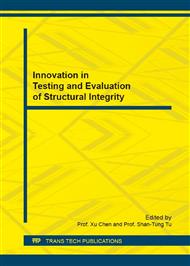p.57
p.62
p.67
p.72
p.77
p.83
p.88
p.92
p.96
Multiaxial Fatigue of 6061-T6 Aluminum Alloy under Corrosive Environment
Abstract:
Aluminium alloys are widely used in the fields of automobile, machinery and naval construction. To investigate the effect of non-proportional loadings and corrosive environment on the fatigue resistance of 6061-T6 aluminum alloy, a set of uniaxial and multiaxial low cycle fatigue tests were carried out. Firstly, the results of uniaxial tests showed that the alloy exhibited cyclic hardening then cyclic softening. With the increase of stress amplitude the cyclic softening became pronounced. The increasing of plastic deformation was basically cyclically stable with small plastic strain amplitude accumulation when the stress amplitude was lower than 200MPa ,while it was increasing rapidly when the stress amplitude was higher than 220MPa. Secondly, it was observed that non-proportional cycle additional hardening of 6061-T6 aluminum alloy was little. While the fatigue life was badly affected by the loading paths. Thirdly ,the fatigue corrosion interactions were also talked about in details by performing the tests under the same loading conditions with corrosive environment. The experiment proved that the seawater corrosion has huge impact on fatigue life under pH 3. Finally, a multi-axial fatigue life prediction model was used to predict the fatigue life with or without the corrosive environment which showed a good agreement with experimental data.
Info:
Periodical:
Pages:
77-82
Citation:
Online since:
September 2016
Authors:
Price:
Сopyright:
© 2017 Trans Tech Publications Ltd. All Rights Reserved
Share:
Citation:


